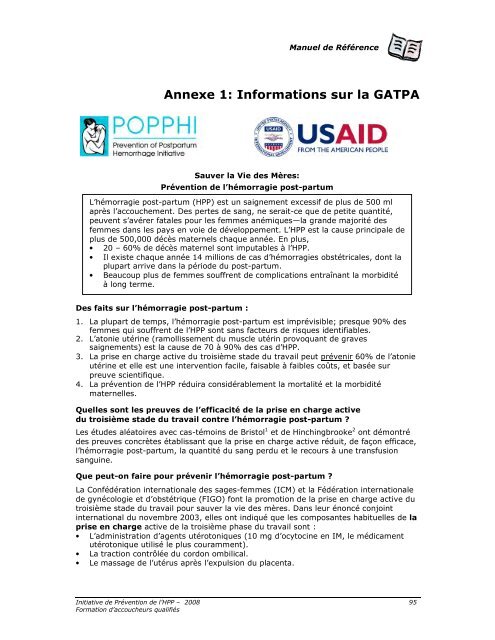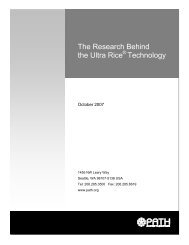La Prévention de l'Hémorragie du Post-Partum: La Gestion ... - Path
La Prévention de l'Hémorragie du Post-Partum: La Gestion ... - Path
La Prévention de l'Hémorragie du Post-Partum: La Gestion ... - Path
Create successful ePaper yourself
Turn your PDF publications into a flip-book with our unique Google optimized e-Paper software.
Manuel <strong>de</strong> Référence<br />
Annexe 1: Informations sur la GATPA<br />
Sauver la Vie <strong>de</strong>s Mères:<br />
<strong>Prévention</strong> <strong>de</strong> l’hémorragie post-partum<br />
L’hémorragie post-partum (HPP) est un saignement excessif <strong>de</strong> plus <strong>de</strong> 500 ml<br />
après l’accouchement. Des pertes <strong>de</strong> sang, ne serait-ce que <strong>de</strong> petite quantité,<br />
peuvent s’avérer fatales pour les femmes anémiques—la gran<strong>de</strong> majorité <strong>de</strong>s<br />
femmes dans les pays en voie <strong>de</strong> développement. L’HPP est la cause principale <strong>de</strong><br />
plus <strong>de</strong> 500,000 décès maternels chaque année. En plus,<br />
• 20 – 60% <strong>de</strong> décès maternel sont imputables à l’HPP.<br />
• Il existe chaque année 14 millions <strong>de</strong> cas d’hémorragies obstétricales, dont la<br />
plupart arrive dans la pério<strong>de</strong> <strong>du</strong> post-partum.<br />
• Beaucoup plus <strong>de</strong> femmes souffrent <strong>de</strong> complications entraînant la morbidité<br />
à long terme.<br />
Des faits sur l’hémorragie post-partum :<br />
1. <strong>La</strong> plupart <strong>de</strong> temps, l’hémorragie post-partum est imprévisible; presque 90% <strong>de</strong>s<br />
femmes qui souffrent <strong>de</strong> l’HPP sont sans facteurs <strong>de</strong> risques i<strong>de</strong>ntifiables.<br />
2. L’atonie utérine (ramollissement <strong>du</strong> muscle utérin provoquant <strong>de</strong> graves<br />
saignements) est la cause <strong>de</strong> 70 à 90% <strong>de</strong>s cas d’HPP.<br />
3. <strong>La</strong> prise en charge active <strong>du</strong> troisième sta<strong>de</strong> <strong>du</strong> travail peut prévenir 60% <strong>de</strong> l’atonie<br />
utérine et elle est une intervention facile, faisable à faibles coûts, et basée sur<br />
preuve scientifique.<br />
4. <strong>La</strong> prévention <strong>de</strong> l’HPP ré<strong>du</strong>ira considérablement la mortalité et la morbidité<br />
maternelles.<br />
Quelles sont les preuves <strong>de</strong> l’efficacité <strong>de</strong> la prise en charge active<br />
<strong>du</strong> troisième sta<strong>de</strong> <strong>du</strong> travail contre l’hémorragie post-partum ?<br />
Les étu<strong>de</strong>s aléatoires avec cas-témoins <strong>de</strong> Bristol 1 et <strong>de</strong> Hinchingbrooke 2 ont démontré<br />
<strong>de</strong>s preuves concrètes établissant que la prise en charge active ré<strong>du</strong>it, <strong>de</strong> façon efficace,<br />
l’hémorragie post-partum, la quantité <strong>du</strong> sang per<strong>du</strong> et le recours à une transfusion<br />
sanguine.<br />
Que peut-on faire pour prévenir l’hémorragie post-partum ?<br />
<strong>La</strong> Confédération internationale <strong>de</strong>s sages-femmes (ICM) et la Fédération internationale<br />
<strong>de</strong> gynécologie et d’obstétrique (FIGO) font la promotion <strong>de</strong> la prise en charge active <strong>du</strong><br />
troisième sta<strong>de</strong> <strong>du</strong> travail pour sauver la vie <strong>de</strong>s mères. Dans leur énoncé conjoint<br />
international <strong>du</strong> novembre 2003, elles ont indiqué que les composantes habituelles <strong>de</strong> la<br />
prise en charge active <strong>de</strong> la troisième phase <strong>du</strong> travail sont :<br />
• L’administration d’agents utérotoniques (10 mg d’ocytocine en IM, le médicament<br />
utérotonique utilisé le plus couramment).<br />
• <strong>La</strong> traction contrôlée <strong>du</strong> cordon ombilical.<br />
• Le massage <strong>de</strong> l’utérus après l’expulsion <strong>du</strong> placenta.<br />
Initiative <strong>de</strong> <strong>Prévention</strong> <strong>de</strong> l’HPP – 2008 95<br />
Formation d’accoucheurs qualifiés
<strong>La</strong> ICM et la FIGO ont ensuite déclaré que “Toute personne assistant à l’accouchement<br />
doit disposer <strong>de</strong>s connaissances, <strong>de</strong>s habiletés et <strong>du</strong> jugement critique nécessaires à la<br />
prise en charge active <strong>du</strong> troisième sta<strong>de</strong> <strong>du</strong> travail, ainsi qu’avoir accès aux fournitures<br />
et au matériel requis.” 3<br />
Il est avéré que l’ocytocine est l’agent utérotonique le plus efficace pour la<br />
prévention <strong>de</strong> l’hémorragie post-partum.<br />
1<br />
Prendiville WJ, Harding JE, Elbourne DR, Stirrat GM. The Bristol third stage trial: active<br />
versus physiological management of the third stage of labour. British Medical Journal<br />
1988; 297: 1295-1300.<br />
2 Rogers J, Wood J, McCandlish R, Ayers S, Truesdale A, Elbourne D. Active versus<br />
expectant management of third stage of labour: the Hichingbrooke randomized<br />
controlled trial. <strong>La</strong>ncet 1998; 351: 693-699.<br />
3 ICM et FIGO. Enoncé conjoint : Prise en charge <strong>du</strong> troisième sta<strong>de</strong> <strong>du</strong> travail pour<br />
prévenir l’hémorragie post-partum. [Enoncé conjoint] 2003.<br />
Initiative <strong>de</strong> <strong>Prévention</strong> <strong>de</strong> l’HPP – 2008<br />
96 Formation d’accoucheurs qualifiés
Manuel <strong>de</strong> Référence<br />
Annexe 2 : Enoncé conjoint <strong>du</strong> FIGO / ICM<br />
Initiative <strong>de</strong> <strong>Prévention</strong> <strong>de</strong> l’HPP – 2008 97<br />
Formation d’accoucheurs qualifiés
Initiative <strong>de</strong> <strong>Prévention</strong> <strong>de</strong> l’HPP – 2008<br />
98 Formation d’accoucheurs qualifiés
Manuel <strong>de</strong> Référence<br />
Initiative <strong>de</strong> <strong>Prévention</strong> <strong>de</strong> l’HPP – 2008 99<br />
Formation d’accoucheurs qualifiés
Initiative <strong>de</strong> <strong>Prévention</strong> <strong>de</strong> l’HPP – 2008<br />
100 Formation d’accoucheurs qualifiés
Manuel <strong>de</strong> Référence<br />
Références<br />
1 Impact International. Measuring and Addressing Outcomes after Pregnancy: A Holistic Approach<br />
to Maternal Health. Impact International: Aber<strong>de</strong>en, United Kingdom; February 2007. Available at:<br />
www.prb.org/pdf07/Outcomes.pdf. Accédé le 2 avril 2007.<br />
2 Newton N M, Mosey LM, Egli GE, Gifford WB, Hull CT. Blood loss <strong>du</strong>ring and immediately after<br />
<strong>de</strong>livery. Obstet Gynecol. 1961;17:9-18.<br />
3 Pierre F, Mexnard L, Body G. For a systematic policy of IV oxytocin direction of third stage of<br />
labor. Eur J Obstet Gynecol Reprod Biol. 1992;43:131-135.<br />
4 Prendiville W, Harding JE, Elbourne DR, Stirrat GM. The Bristol third stage trial: active versus<br />
physiological management of third stage of labour. BMJ. 1988, 297:1295-1300.<br />
5<br />
Combs CA, Murphy EL, <strong>La</strong>ros RK. Factors associated with post-partum haemorrhage with vaginal<br />
birth. Obstet Gynecol. 1991;77:69-76.<br />
6 Combs CA, Murphy EL, <strong>La</strong>ros RK. Factors associated with haemorrhage in caesarian <strong>de</strong>liveries.<br />
Obstet Gynecol. 1991;77:77-82.<br />
7 Gahres EE, Albert SN, Do<strong>de</strong>k SM. Intra-partum blood loss measured with Cr 51 tagged<br />
erythrocytes. Obstet Gynecol. 1962;19:455-462.<br />
8 Nelson GH, Ashford C, Williamson R, Amburn SD. Methods for calculating loss at vaginal <strong>de</strong>livery.<br />
South Med J. 1981;74:550-552.<br />
9<br />
Dombrowski MP, Bottoms SF, Saleh AA, Hurd WW, Romero R. Third stage of labor: analysis of<br />
<strong>du</strong>ration and clinical practice. American Journal of Obstetrics and Gynecology. 1995;172:1279–84.<br />
10<br />
Gulmezoglu AM, Villar J, Ngoc NN, Piaggio G, Carroli G, A<strong>de</strong>toro L, et al. WHO Collaborative<br />
Group to Evaluate Misoprostol in the Management of the Third Stage of <strong>La</strong>bour. WHO multicentre<br />
randomised trial of misoprostol in the management of the third stage of labour. <strong>La</strong>ncet<br />
2001;358:689–95.<br />
11 Everett F, Magann EF, Evans S, Chauhan SP, <strong>La</strong>nneau G, Fisk AD, Morrison JC. The Length of<br />
the Third Stage of <strong>La</strong>bor and the Risk of <strong>Post</strong>partum Hemorrhage. Obstetrics & Gynecology.<br />
2005;105(2): 290–293.<br />
12 Rogers J, Wood J, McCandlish R, Ayers S, Truesdale A, Elbourne D. Active versus expectant<br />
management of the third stage of labour: the Hinchingbrooke randomized controlled trial. <strong>La</strong>ncet<br />
1998;351:693–699.<br />
13<br />
Adapté <strong>de</strong>: PATH. OUTLOOK Volume 19, Numéro 3, Mai 2002.<br />
14<br />
OMS. Prise en charge <strong>de</strong>s complications <strong>de</strong> la grossesse et <strong>de</strong> l’accouchement: Gui<strong>de</strong> <strong>de</strong>stine à la<br />
sage-femme et au mé<strong>de</strong>cin. Genève: OMS, 2002.<br />
15 Yao AC, Moinian M, Lind J. Distribution of blood between infant and placenta after birth. <strong>La</strong>ncet.<br />
1969;7626:871–873.<br />
16 JHPIEGO. Les précautions universelles. CD-ROM.<br />
17 Engen<strong>de</strong>rHealth. Cours sur ligne: <strong>La</strong> prévention <strong>de</strong>s infections. www.engen<strong>de</strong>rhealth.org. Accédé<br />
le 16 août 2006.<br />
18 Graphics from World Health Organization and the U.S. Centers for Disease Control and<br />
Prevention in partnership with the Francois-Xavier Bagnoud Center at the University of Medicine &<br />
Dentistry of New Jersey (UMDNJ) and JHPIEGO at Johns Hopkins University. Prevention of Motherto-Child<br />
Transmission of HIV Infection Generic Training Package. February 2005.<br />
http://www.womenchildrenhiv.org/wchiv?page=pi-60-00. Accédé le 12 avril 2007.<br />
19<br />
JHPIEGO. Infection Prevention: Gui<strong>de</strong>lines for Healthcare Facilities with Limited Resources.<br />
JHPIEGO: Baltimore, 2003.<br />
20 JHPIEGO/MNH. Birth Preparedness and Complication Readiness. Baltimore, MD: JHPIEGO/MNH,<br />
2001.<br />
Initiative <strong>de</strong> <strong>Prévention</strong> <strong>de</strong> l’HPP – 2008 101<br />
Formation d’accoucheurs qualifiés

















